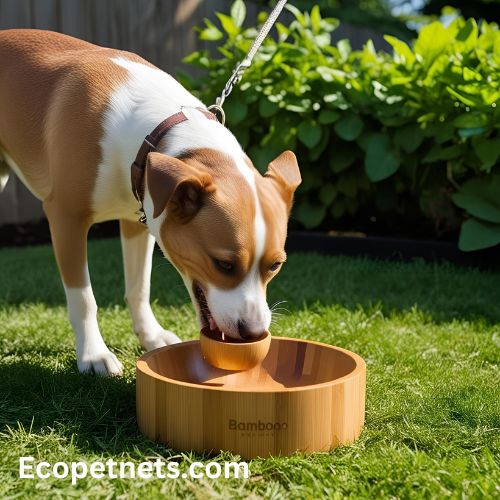
Best Eco-Friendly Alternatives to Plastic Pet Bowls
As pet owners, we want the best for our furry friends, from nutritious food to comfortable bedding. However, one aspect often overlooked is the environmental impact of the products we use daily, including pet bowls. Traditional plastic pet bowls are ubiquitous due to their affordability and convenience, but they pose significant environmental concerns. In this article, we explore the best eco-friendly alternatives to plastic pet bowls that are safe for your pets and better for the planet.
Why Avoid Plastic Pet Bowls?
Plastic pet bowls are made from petroleum-based materials that contribute to pollution during production and disposal. Over time, plastics can degrade and leach harmful chemicals such as BPA (bisphenol A), which may affect your pet’s health. Additionally, plastic bowls can develop scratches that harbor bacteria, making them unhygienic. From an environmental standpoint, plastic waste contributes to landfill overflow and microplastic pollution in oceans and waterways.
Eco-friendly pet bowls offer a sustainable solution that reduces environmental impact while providing durable, safe, and aesthetically pleasing feeding options.
Top Eco-Friendly Alternatives to Plastic Pet Bowls
- Stainless Steel Bowls
Stainless steel is one of the most popular eco-friendly alternatives to plastic. It is non-toxic, durable, and resistant to bacteria. Stainless steel bowls don’t retain odors or stains, making them hygienic and easy to clean. They are also dishwasher safe and long-lasting, reducing the need for frequent replacements.
From an environmental perspective, stainless steel is recyclable, and many manufacturers use recycled materials. When choosing stainless steel bowls, opt for those made with high-quality, food-grade stainless steel to ensure safety.
- Bamboo Bowls
Bamboo is a rapidly renewable resource, making bamboo pet bowls an excellent eco-friendly choice. Bamboo bowls are lightweight, biodegradable, and often handcrafted, giving them a natural aesthetic appeal. They are generally made from bamboo fiber mixed with natural resins or other plant-based materials, which enhances durability.
However, it is important to ensure that the bamboo bowls you purchase are free from harmful chemicals and coatings. Also, bamboo bowls are typically not dishwasher safe and require hand washing to maintain their integrity.
- Ceramic Bowls
Ceramic pet bowls are made from natural clay, which is fired at high temperatures to create a durable, non-toxic surface. Ceramic bowls are heavy, which helps prevent tipping, and they come in a variety of styles and colors. They are easy to clean and generally dishwasher safe.
From an eco-friendly standpoint, ceramic bowls are better than plastic as they are made from natural materials. Although they are not biodegradable, ceramic bowls have a long lifespan and can be recycled or repurposed. Look for bowls made with lead-free glazes to ensure they are safe for your pets.
- Glass Bowls
Glass pet bowls are non-toxic, easy to clean, and do not retain odors or stains. They are typically dishwasher safe and can last for many years if handled with care. Glass is recyclable and made from natural materials like sand, making it an eco-friendly choice.
The main drawback of glass bowls is their fragility—they can break if dropped, which may be a concern for active pets or households with children. Tempered glass options offer increased durability for such cases.
- Silicone Bowls
Silicone bowls are flexible, lightweight, and often collapsible, making them convenient for travel. Food-grade silicone is non-toxic, heat resistant, and easy to clean. Silicone is more durable than plastic and does not leach harmful chemicals.
While silicone is a synthetic material derived from silica, it is considered more environmentally friendly than plastic due to its longer lifespan and inert nature. Silicone is recyclable in some facilities, but it’s important to check local recycling programs.
- Coconut Shell Bowls
For pet owners seeking a truly natural and biodegradable option, coconut shell bowls are an excellent choice. These bowls are handcrafted from discarded coconut shells, giving them a unique and rustic look. They are lightweight and naturally resistant to bacteria.
Coconut shell bowls are biodegradable and compostable at the end of their life, reducing environmental impact. However, they may not be as durable as other options and often require hand washing.
Tips for Choosing and Maintaining Eco-Friendly Pet Bowls
- Safety First: Ensure the materials used are non-toxic, food-grade, and free from harmful chemicals such as BPA, lead, or phthalates.
- Size and Design: Choose bowls that suit your pet’s size and eating habits. Heavier bowls prevent tipping, while shallow bowls are better for flat-faced breeds.
- Durability: Opt for bowls that will last to reduce waste. Durable materials like stainless steel and ceramic often provide the best longevity.
- Cleaning: Regular and thorough cleaning prevents bacterial growth. Many eco-friendly bowls are dishwasher safe, but always check manufacturer guidelines.
- End of Life: Consider how the bowl can be disposed of or recycled. Biodegradable options like bamboo and coconut shell reduce landfill waste.
Why Switching Matters
Choosing eco-friendly pet bowls supports a healthier planet by reducing plastic waste and pollution. Additionally, many eco-friendly materials provide safer feeding options for your pets, minimizing exposure to harmful chemicals. By making conscious choices in everyday products, pet owners can contribute to environmental sustainability and promote the well-being of their animal companions.
Recycled vs Organic Pet Toys: Which Is the Better Choice for Your Furry Friend?
Conclusion:
Plastic pet bowls may be convenient, but their environmental and health drawbacks make them less than ideal. Thankfully, there are numerous eco-friendly alternatives available, including stainless steel, bamboo, ceramic, glass, silicone, and coconut shell bowls. Each option offers unique benefits in terms of sustainability, safety, and style.
When selecting an eco-friendly pet bowl, consider your pet’s needs, the material’s durability, and environmental impact. By switching to sustainable pet bowls, you help reduce plastic pollution, protect wildlife, and create a safer feeding environment for your beloved pets. Embrace eco-friendly choices and make a positive difference—one bowl at a time.
